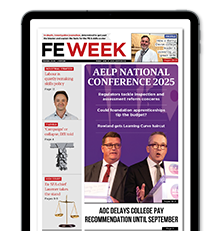Education providers should appoint “security leads” and devise emergency response plans, new anti-terrorism guidance states.
The recommendations have been included in documents published by government setting out “cost-effective methods” to keep learners and staff safe.
The non-statutory guidance does not appear to outline new responsibilities on schools, colleges and providers. It is more that it “adapts principles from the National Counter-Terrorism Security Office (NaCTSO) into more sector-specific advice”, the Department for Education said.
Here’s what you need to know…
1. Plans to ‘deter’ terrorists
The document recommends providers devise response plans “to reduce the risk of terrorist incidents and other incidents by making it difficult for someone intending to cause harm to target their sites”.
Staff should be able to draw on their knowledge of these strategies during emergencies to “make good, informed judgements about how to keep themselves and others safe”.
So-called “bomb threat checklists” should also be created. All members of staff are expected to “be familiar with the processes” detailed in them.
2. Appoint security and incident leads
Providers should appoint a “security lead”. They will be charged with developing and maintaining emergency plans and policies.
They will also be expected to ensure their colleagues “are aware of their roles and responsibilities” and liaise with external agencies, like the police.
During an emergency, they will normally become the provider’s “incident lead” to make “fast, clear decisions under pressure, to get people to safety”.
Providers are advised to have “one or two” employees available to deputise for them should they be absent.
3. Practice drills
The guidance says it is “relatively uncommon” for practice drills to involve early years and primary school children. These settings are advised to hold the exercises on occasions when youngsters are not present.
In secondary schools, colleges and other post-16 providers drills work best “as part of a wider plan to share security awareness and incident response plans in an age-appropriate way”. Learners with SEND should not be excluded.
“Staff should ensure that discussions and activities are conducted with sensitivity and awareness of the learner’s comfort levels … it is important not shock or frighten learners,” the guidance adds.
“Discussions and drills should focus on safety procedures and avoid implying the motivations for a possible attack.”
It is also advised that councils and the police are contacted “to either take an active part in your practice drill … or to help evaluate it”.
4. Responses to bomb threats and suspicious packages
To help identify suspicious packages, providers are told to “keep clutter to a minimum”.
They are advised to assess whether the item is hidden, “obviously suspicious” and typical of what you expect to find in that part of the provider when deciding if further action is required.
Areas should be cordoned off and the police called when suspicious items are identified. Radios and phones should not be used within 15 metres of the item.
If an evacuation is necessary, learners and staff should move to a location 100 metres away if the item is small, like a rucksack, 200 metres away if it is a small vehicle or large item, such as a car or wheelie bin, or 400 metres away if it a van or lorry.
Meanwhile, any bomb threats should be reported to the police. The guidance tells staff to “record and retain all evidence and make this available to” officers in these cases.
This can involve dialling 1471 following calls to identify the number used to make the threat and keeping hold of any menacing messages or voicemails.
5. Code words and signals
The guidance stresses that any communication methods, including any code words and signals, should be planned in advance.
Initial alerts to staff about potential incidents can include the use of existing alarms, internal phone systems, a tannoy or silent broadcasts or messages to staff devices.
Coded messages can also “convey a message to staff without scaring learners”. The guidance suggests these could “mimick a normal announcement” or use a “set of colours, numbers, trees, or anything else”.
During an incident leads and staff “need one or more communication methods to exchange information and instructions with one … until the police and emergency responders arrive”.
These should “silent and invisible” to those wanting to cause harm, allow for two-way communication and not be “dependant on your normal WiFi and wired connections”.
Initial messages to parents – chosen from “a selection of holding statements” – should be sent by the provider. They should “be clear that parents and carers should temporarily stay away from the site”.
Responding to press and social media enquiries, meanwhile, “are low priority in comparison”.
5. Grab kits filled with essentials
Providers have also been told to compile “grab kits” filled with “key items that can assist during an incident”.
The packages, which should be dotted around providers, can contain first aid kits, communication equipment – including phones and notepads and pens – and key information, medication lists and site plans.
However, staff “should not put themselves in additional danger to collect a grab kit”.









Your thoughts